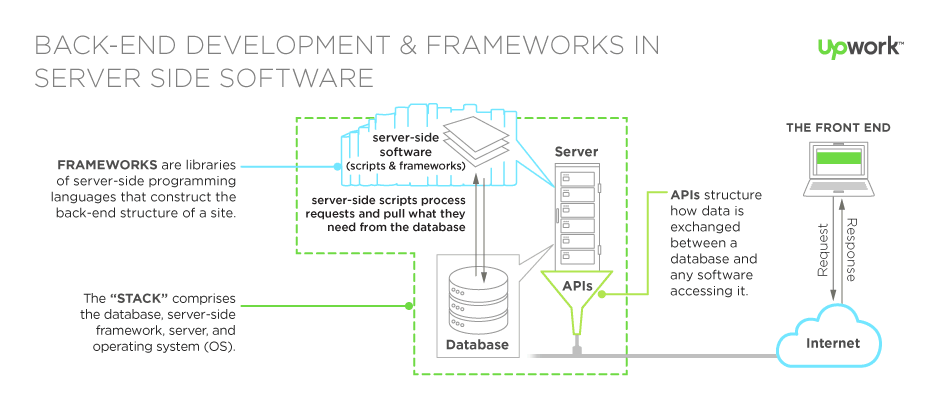
What’s The Difference Between A Front-End, Back-End and Full-Stack Developer?

Don’t be put off by buzzwords and tech jargon. Learn what a “front-end”, a “back-end”, and a “full-stack” developer does and give yourself the confidence to approach them with firm knowledge and a better understanding of their roles. Some of these differences are substantial and some are subtle, but all are necessary to have a clear view of the needs in the IT industry.
The demand for developers grows every day but so do the requirements for the job. There are more web tools being built than ever before and more and more people are relying daily on software technology around the globe. So whether you are looking to hire one, or want to become one, it is good to get a good understanding of what the titles “front-end”, “back-end” and “full-stack” developer mean.
To better understand each of the roles and bring closer the person behind the magic, we will cover what skills a person in one of these positions traditionally has, what technology they use, and what need they are solving with their work.
The Front-End Developer
If you’ve ever wondered what makes a website come alive and who makes the magic that you see happen, you’re thinking of a front end developer without even knowing it. Essentially, whatever has a visual presence with which people interact is made by with the blood, sweat and tears (mostly tears) of front end developers.
You might have seen some terms, buzzwords, keywords that will always be associated with the front end. Brace yourselves, we’re about to get a little technical.
GUI, or “Graphical User Interface”, is a visual front that a screen displays to allow customers to interact with the software. Any of today’s devices with the adjective “smart” added to them will have an interface that runs apps, gives access to websites and all of it is built by a front end developer.
UI designer, or “User Interface” designer, creates the space where interactions between human and machine occur. In terms of skill, it demands from the programmer a mix of programming and design skills, and oftentimes this person does not have to be a programmer at all.
UX designer refers to a “User Experience” designer, which describes the path that a user takes and its overall effectiveness. Front end developers are also concerned with the overall usability, utility and experience that a user has when interacting with the software and this particular segment requires by far the most “soft skills” of a programmer. However, this does job is also done by non-programmers.
Responsive Design, on the other hand, is a very tough job. It refers to the process of adapting the design of the interface to fit any and every screen, from widescreen desktops and laptops to mobile devices like tablets and smartphones.
Traditionally, a front end developer is a person who is comfortable with both design and coding; in other words someone who is comfortable using simple design tools and is able to write the framework of the website in HTML and style it using CSS code. The problem front-end developers have nowadays is that a website built only using HTML and CSS would be completely static. If you think of a stickman on a blank page as a website. HTML would be enough to draw its shape and CSS would be used to style it (thicken it, colour it, add some clothes, etc.) But to make the stickman move, react and respond, front-end developers need something more.

As websites and web applications have grown in complexity, the demand for Turing complete programming languages in the front end is growing at great speeds, so to animate the stickman programmers use JavaScript, which is a browser side programming language.

It uses the browser to compute and does so faster than a server side language. In fact it is the backbone of almost all websites and web application on the front end today and for those who know where to look, JavaScript makes the entire code transparent – just click “inspect element” to see some JavaScript, HTML, and CSS. We’ve previously written about JavaScript on our blog, so for a detailed look at this technology check out: How to screen JavaScript developer skills to find the best – guide for IT recruitment. There are more skills that a front end developer might need, and this article from Skillcrush covers them in great detail.
Specialization in this field involves being either more design or more programming oriented, with an increasing demand for knowledge of JavaScript and its frameworks.
Software today has become a much more human experience, where we interact with it to allow computational power to do a lot of work for us. Front end makes it possible for us to give clear and direct input to a system. However, it terms of software’s absolute capacity, the front end is only the part we see. The processing of information and the bulk of computational activity still happens behind it. This leads us to the back end.
The Back-End Developer
So what is “back-end” and what does a back end developer do that is different to a front-end developer?
In the past the back-end would consist of a physical computer and software designed to run requests through it. Today on the other hand, this has become infinitely more complex, with cloud servers being more common, databases and microservice applications, but fundamentally it still remains a process of combining a server, an application, and a database to solve a problem.
The entire process is solidly entrenched in logic, a network of processes and queries being resolved in split seconds to give you, as a user, a certain desired output. Select a flight from New York to Hong Kong and you are in the front end, press the “search” key and you are completely relying on the back end to correctly return to you the best, shortest, cheapest flight in no time. Once the results are displayed for you, you are in the front-end again. But if the flight search query ends up being sensible and timely, and you have no idea who and how made it happen, thank a back end developer for making the search, as well as countless other things, seem uber-easy.
A back-end developer can have a variety of duties. From database creation and integration to security, and backup and restore technologies, back-end developers make the brain of the application.

Source: Upwork
Back-end developers use a variety of technologies to code the core computational logic of information systems, particular software, or websites. They can include Java, C#, Python, and database languages like SQL and many others.
Back-end developers normally specialize in one programming language and the senior programmers tend to have an extensive knowledge of frameworks, libraries, and other dependencies of that language.
They are different from front-end developers in that the job of a back-end developer is completely free of any visual design and relies on logical reasoning and software architecture that aims to deliver a particular output. There are sometimes problems unifying the back end and the front end, which leads us to the person who is equipped to handle both.
The Full-Stack Developer.
A full stack developer is one who is comfortable working with both backend and frontend technologies. “To be more specific, it means that the developer can work with databases, PHP, HTML, CSS, JavaScript, and everything in between, also, venturing as far as converting Photoshop designs to front-end code.” Says Sitepoint.

Source: Sitepoint
A general knowledge of technologies from every section of the development process is necessary for a full-stack developer. This of course, means that they will not be an expert in any one particular field but can rather offer a better overview of applicational possibilities and capability of bridging the gap between how the system functions and how it looks and feels for the user. Perhaps not a requirement for the title, but a full stack developer normally also understands business logic, limits of design, and user interface. Early stages of business development might have a great need for full stack developers since their versatility can be useful in the development of the product, but as the company matures the developers need more and more focused skills. In 202o, the popularity of front end and back end technologies tested together suggests that the demand for dull attack developers is only increasing.
Full stack developers can also be a great CTO. They have a broad understanding of technology and can anticipate what future recruitment efforts need to be or what technologies need to be implemented next.
Devskiller’s own CTO is in fact, a Full Stack Developer.
Before you go
Check out our other comprehensive resources devoted to differences between various job positions:




